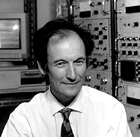|
History - People -
My research is focused on two main areas: surface chemistry of gases on oxides and interfacial electrochemistry. A major theme of our work is the development of new chemical sensors. I am co-director of the Centre for Cosmic Chemistry and Physics and a member of the Centre for Materials Research and the Bloomsbury Institute for the Natural Environment . Surface chemistry of semiconducting oxidesThe resistivity of semiconducting oxides at elevated temperature is very sensitive to the presence in the atmosphere of trace concentrations of reactive gases. We compare the behaviour of complex oxides with surface and bulk compositions systematically altered, and use computational chemistry models to help develop interpretations. The aim of this work is to understand the surface chemistry in detail. The industrial interest of this work lies in the development of a new generation of hazardous gas monitoring equipment. I founded Capteur Sensors Ltd. to exploit the applied aspects of this work. Applications of sensors in environmental chemistryI collaborate on study of the surface chemistry of particulates in the urban atmosphere, and in development of devices for ozone (troposphere and stratosphere) and VOC measurement. Interfacial electrochemistryElectrochemistry is a wide-ranging branch of science, and the studies in my laboratory range from corrosion science, through semiconductor electrochemistry and new electrochemical methods of analysis, to the study of organisation, dynamics and reactivity at the electrified liquid-liquid interface ( ODRELLI ). Recent achievements have been: imaging electrochemistry, using both photoelectrochemistry with a scanning laser microscope and high resolution mapping of current; inexpensive industrial analytical devices using electrodes produced by industrial printing methods; and an area-modulation method for liquid-liquid interface studies.
Further details about the XPS spectrometers at UCL is available. Selected Publications
This page last modified 20 September, 2010 |


![[A schematic diagram of imaging methods.]](images/pem.gif)